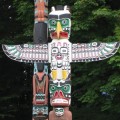In 1863 the Coal Harbour peninsula, which makes up most of today's Stanley Park, became a military reserve. Surveyed by Colonel Moody's Royal Engineers, the thick timbered region commanded a view of the First Narrows entrance to Burrard Inlet. Americans had made the colony nervous with a military occupation of the San Juan Islands in the Gulf of Georgia only four years earlier. To ensure British control of the harbor entrance, a similar military reserve was established directly across the inlet on the north shore.
Natives had hunted and gathered for centuries in what is now Stanley Park. Coal Harbour once teemed with herring, its beaches rich with clams. Whales entered the bight to feed. Cougars roamed the forests. The peninsula's first roads were paved in 1888 with seashells from the Salish peoples' middens. These mounds of cultural debris covered almost two hectares and were up to 2.5 metres deep. One was a seasonal campsite for one of the largest Squamish villages. It later lay abandoned after a smallpox epidemic broke out between 1888 and 1892. Deadman's Island became an isolation site and burial ground for disease victims. The island's Douglas firs and red cedars also held Squamish and Musqueam bentwood boxes which contained their dead. The area's first white settler, a Scottish calico printer named Jimmy Sievewright, set up a camp in 1858 with friends at the site of today's Second Beach. Portuguese ship-jumper Peter Smith, who settled at Brockton Point, used the island to render blubber from whales caught in the harbor. In 1859 Francis Brockton, chief engineer on HMS Plumper, discovered coal nearby. Plumper's captain, George Henry Richards, named the waters Coal Harbour. In the early 1860s a Squamish village of four homes and a lodge-called Whoi-Whoi, meaning "masks" or "great village"-stood at the site of today's Lumberman's Arch. It hosted huge potlatches, attended by thousands of native people.
In May 1868 John "Gassy Jack" Deighton applied unsuccessfully to lease land to start a fishery in what is now Stanley Park. Five logging companies operated in the forests of the park-to-be. (Large stumps in today's park still bear the notches from loggers' springboards used for standing support while wielding a crosscut saw.) Most of today's trails in Stanley Park owe their start to logging, where they began as skid roads. Even before the area was declared a park, Lauchlan A. Hamilton, land agent for the Canadian Pacific Railway, and a Vancouver alderman, surveyed its first roads. The perimeter road of today's park is virtually identical to Hamilton's original routing. Vancouver newspapers began to discuss the future of the military reserve, which was no longer needed for defence, as a park. But the major initiative for the transformation came from a powerful land speculator, Arthur Wellington Ross. A park of untouched forest offered a valuable drawing card for realtors whose property was near. Ross co-owned adjacent property with H.F Ceperley, head of one of Vancouver's most successful real estate companies, Ross and Ceperley. Ross pitched his vision for a park to his friend, the influential William Van Horne of the CPR, even boating him around the reserve for a first-hand look. Van Horne agreed to speak to well- placed people in Ottawa, and he and Ross then talked to Alderman Hamilton, who speedily brought the idea before the city council.
The first resolution of Vancouver's first city council was a request to the federal government on May 12, 1886, to grant the First Narrows Military Reserve to the city as a park. A year later, the federal government established Stanley Park on a leasehold basis.
Mayor David Oppenheimer officially opened the park on September 17, 1888, declaring it a place where Vancouver's 6,000 inhabitants could "spend some time amid the beauties of nature away from the busy haunts of men." Several weeks earlier Oppenheimer had written to the CPR's Sir Donald Smith in Montreal asking him to name the park on behalf of Vancouver. Smith asked Governor General Lord Stanley to allow the park to be called by his family name and he agreed. Lord Stanley dedicated the park on October 29, 1883, during the first visit to Vancouver as a Governor General. An observer wrote: "Lord Stanley threw his arms to the heavens, as though embracing within them the whole of one thousand acres of primeval forest, and dedicated it to the use and enjoyment of peoples of all colours, creeds, and customs, for all time."

